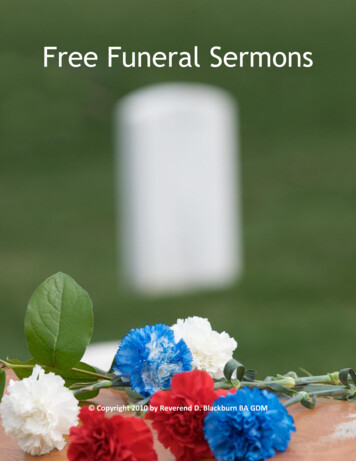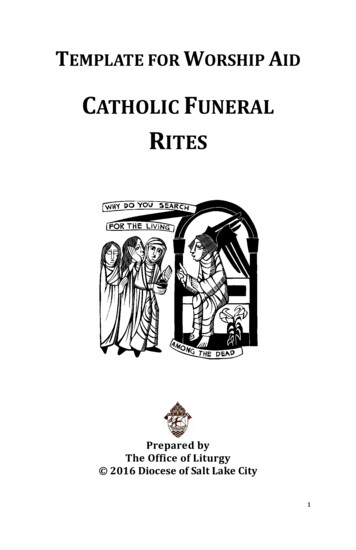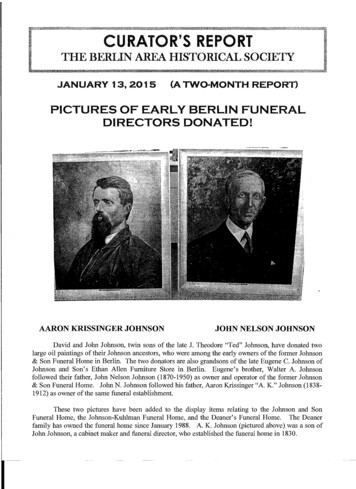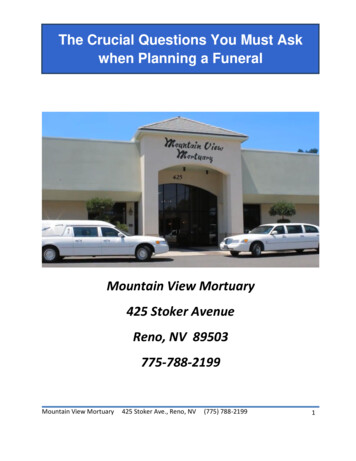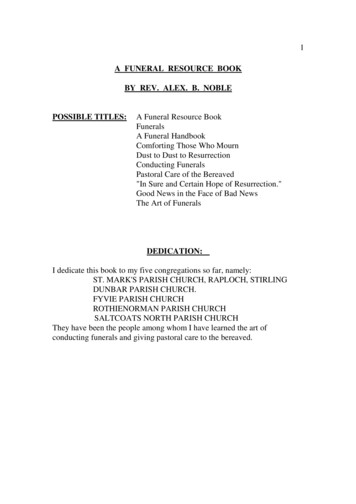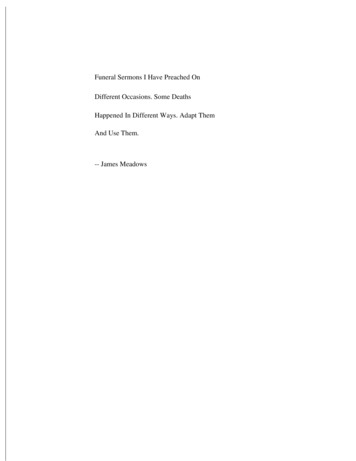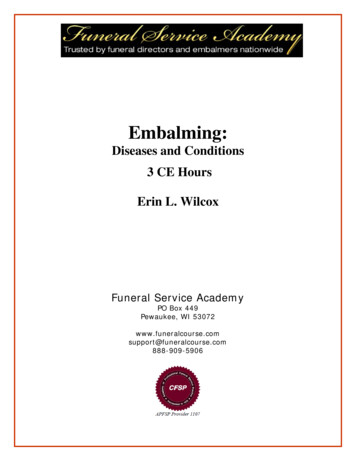
Transcription
Embalming:Diseases and Conditions3 CE HoursErin L. WilcoxFuneral Service AcademyPO Box 449Pewaukee, WI m888-909-5906
Course InstructionsEach of the course PDFs below contain a preview of thefinal exam followed by the course material.The exam is identical to the final exam that you will takeonline after you purchase the course. You may use thisexam preview to help you study the course material.After you purchase the course online, you will be takento a receipt page which will have the following link:Click Here to Take Online ExamSimply click on this link to take the final examand receive your certificate of completion.3 Easy Steps to Complete a Course:1.Read the course material below.2.Purchase the course online & takethe final exam.3.Print out your certificate.If you don’t pass the exam, no problem –you can try it again for free!
Funeral Service AcademyPO Box 449 Pewaukee, WI 53072support@funeralcourse.comFinal Exam - PREVIEWCourse Name: Embalming: Diseases and Conditions (3 Contact Hours .3 CEUs)1.Today, the most commonly-used injection apparatus is .a.Gravity injectionb.The air pressure machinec.The bulb syringed.The embalming machine or centrifugal pump2.The is an instrument that can be used during the embalming of autopsy casesto inject two regions at the same time.a.Stopcockb.Y tubec.Hydroaspiratord.Grooved director3.are used in embalming fluids to maintain the pH balance of the ctants4.Standard cases, although rare, require about a primary dilution factor toachieve a good preservation and sufficiently disinfect the body.a.15-17%b.10-11%c.5-6%d.2-3%5.If the embalmer is required to raise both arteries and veins from all three major injectionsites, this is called a .a.Split injection and drainageb.Six-point injection
c.d.One-point injectionMistake6.composed of blood and blood clots, interstitial fluid, lymphatic fluid, andembalming solution, is a crucial part of the arterial n7.which allows the embalmer more control over the head, is recommended indealing with jaundice cases.a.Using cavity fluids as arterial fluidsb.Mild arterial solutionc.Restricted cervical injectiond.Avoiding the use of dye8.When a diabetes case is presented, the embalmer must keep in mind that there are severalconditions that will most likely accompany the disease, including .a.Jaundiceb.Edemac.Arteriosclerosisd.An excess of bilirubin9.is immensely important when embalming an obese body, as the fatty tissuedoes not take very well to the arterial embalming.a.Hypodermic embalmingb.Opaque cosmeticc.Mild arterial solutiond.Dye10.are very small petechial hemorrhages that are caused from the rupture of tinyblood vessels.a.Purpurab.Tardieu spotsc.Hematomad.Ecchymosis
CONTINUING EDUCATIONfor Funeral DirectorsEmbalming —Diseases & Conditions3 CE HoursLearning ObjectivesThis course provides a review of standard embalming terminology andprocedures, followed by an examination of more complicated scenarios,including purge, obesity/emaciation, diabetes, jaundice, and gangrene.By the end of the course, learners should be familiar with: E mbalming Equipment, Instruments, and Supplies E mbalming Chemicals: Preservatives, Modifying Agents, Germicides, Dyes,Masking Agents, & Vehicles A rterial Embalming: Pre-Arterial Embalming, During Arterial Embalming,Post-Arterial Embalming C avity Embalming A dvanced Embalming: Jaundice, Edema, Diabetes Mellitus, Gangrene,Pruritus, Decubitus Ulcers, Emaciation, Obesity, Purge, Discolorations A dvanced Embalming: Shipping Human RemainsNOTE: Links and illustrations provided within the course material are for informational purposes only.No endorsement of processes or products is intended or implied.FUNERAL SERVICE ACADEMYEmbalming — Diseases & Conditions 1
Introduction and HistoryEmbalming, as defined by The InternationalConference of Funeral Service Examining Boards, isthe chemical treatment of the dead human body toreduce the presence and growth of microorganisms,to temporarily inhibit organic decomposition, and torestore the dead human body to an acceptable physicalappearance.1The history of embalming dates back to the ancientEgyptians, who mummified and preserved their deadfor primarily religious reasons: they believed the bodyneeded to remain intact so that the spirit could rejoinit in the afterlife. The Egyptian mummification processbegan with the removal of the brain, using a metalhook pushed through the ethmoid bone. Eviscerationof the organs, except for the kidneys and sometimesthe heart, was performed; while we don’t know whathappened to all the organs, most were next immersedin wine or packed in salts such as natron. The entirebody was then submerged in a natron solution, usuallyfor 20 days. On the 20th day, the body was removedfrom the natron, washed with water, and dried in thesun.2 The body was then coated with a resin mixtureand wrapped, while the preserved organs were put into4 different canopic jars, representing the 4 children ofHorus.In the United States, the Civil War brought attentionto the art of embalming. The movement of troopsmeant that, for the first time, significant numbers ofAmericans were dying far away from their homes andfamilies; in order to return the soldiers home to beburied, surgeons employed embalming techniques.The process quickly became widespread – people whowished to pay respects to their loved ones, and retainthe memory of how they looked prior to disease,accident, or similar, needed a professional to preparetheir bodies for this purpose – and the specializedposition of “embalmer” was born. In a poignantexample, after his death by assassination, PresidentAbraham Lincoln was embalmed; his body traveledby train from Washington, DC to Springfield, IL, withmany stops along the way for a mourning nation topay their respects.to the undertaker’s home, and eventually funeralestablishments, or separate buildings only housing thebusiness of funeral undertaking, became the norm.Today, even with cremation rates on the rise,embalming is still a service that is chosen by manyAmericans. In addition to being required for mostpost-mortem public transportation, embalming isrecommended for any pre-cremation or pre-burialviewing of remains – especially for public viewing.Embalming:Equipment, Instruments, and SuppliesA wide variety of equipment and instruments are usedby embalming professionals, along with numeroussupplies to help set the features and prevent leakage,among other things.EquipmentBody boards are used to assist in the movement ofbodies. They are thin and can easily be slid under thebody to help move the body from one table or cot toanother.Body lifts are another method used to move the bodyfrom one place to another. Body lifts can be mountedto the ceiling, or they can be a movable device. Theycan be hydraulic or electric. Body lifts can move thebody from the table to the casket, or the table tothe shipping container, or even table to table. If alift device is available, it should be utilized to avoidinjuring the embalmer.Coolers can drastically range in size and style. Manycooling units are custom made for the space available.The refrigeration temperature should range from 35-45degrees Fahrenheit. Coolers should have the capacityto be locked, and have a detailed log of each decedentgoing in andout of thecooler.Fahrenheit.Coolersshouldhave the capacity to be locked, aneach decedent going in and out of the cooler.This was the first time in American history thatembalming was available to everyone who wanted it,and it gave rise to the funeral industry as we knowit today. At first, the home remained the center ofactivity surrounding a death; initially, embalmingmight even be done at the home of the deceased.Wakes and viewings were often done at the decedent’sresidence, as well, with the actual funeral taking placethere, at the church, or at the cemetery. But as deathbecame something people did not want to deal with,more and more of the work was turned over to theundertaker: funerals moved from the family home1 The Conference, 20122 Mayer, 2012, p. 4722 Embalming — Diseases & ConditionsThisThiscoolerhas individuallockerslockersfor nineforbodies.coolerhas individualnine bodies.FUNERALSERVICEACADEMYThe injection apparatus is usedto injectarterialsolution into thembalming process.
are adjustable, and some fold in half for easystorage.can geninstrumentsplated with nickel orThe injection apparatus is used to inject arterial solutiondurable.into the body during the embalming process.Historical methods include the bulb syringe, gravityinjection, combination gravity and bulb syringe, handpump, and the air pressure machine.The bulb syringe is hand operated and is made of arubber bulb with hoses attached to either end.Gravity injection utilizes gravity to create the pressureneeded to get the arterial solution into the body.The combination gravity and bulb syringe uses gravity,but also adds the bulb syringe to increase pressure.The hand pump has one hose to create pressure andone hose to create a vacuum.Finally, the air pressure machine is like the handpump, but is motorized.Instruments shouldsterilizing chemicalAlthough disinfectinthe decedent did noEmbalming tableset up insufficient.the prep It shoulddisease-causingmicroom. Thefoot endis slightlylower thanspreadingmicroorgathe head end and isover the drain bowl.Notice the drainingchannel that goes allthe way around thetable.Gravity injection is still utilized in some anatomicalembalmings,3 and any of the above methods maybe considered for use due to power outage ormalfunction in the primary injection apparatus.Today, the most commonly-used injection apparatusis the embalming machine or centrifugal pump. MostInstrumentscentrifugal pump embalming machines sis the embalming machinea large tank to hold the embalming solution,FuneralThe instruments used in the 2016prep roomcome inServicemany Academpump.Most centrifugalembalmingmachines containa largeandorarecentrifugalable to maintaina constantflow with a pumpsizesand varieties. These instruments can generallytank to holdthe embalmingsolution,and areto maintainconstantflowpredeterminedpressure.Many machinesallow thebeableused formany tasksaandare usuallymade of h a predetermined pressure. Many machinesallowthenickelembalmerto controland platedwithor chrome.They are chemicallythe embalmer sets them prior to injection, andto be heatand durable.the pressure and rate of flow: the embalmertreatedsets thempriorresistantto injection,and thenthen adjusts them as needed during the embalmingA variety of embalmingadjustsas machinesneeded duringthe embalmingprocess.Somemodern machinesInstrumentsshouldbe thoroughlydisinfected orprocess.Somethemmoderneven automaticallysterilized afteruse. A good coldsterilizingevenset theof flow and pressurefor eachthe embalmer.(Pressureset therateautomaticallyof flow and pressurefor ratethe embalmer.Let’s start with the lowwillbediscussedinmoreand rate of flow will be discussed in more detail on page 19 of this text.) for theallof the embalmingsterilization of most instruments. Although disinfectingdetail on page 11 of this text.)is not at the same level as sterilization, forstandardtheend. This instrucases where the decedent did not have a findingcontagiousand raising vdisease, disinfection may be considered sufficient. Itmain difference in sshould be noted, however, that only proper sterilizationnamefew.can ensure disease-causing microorganismshaveabeenkilled. Sterilization is best to preventspreading microorganisms to otherbodies, and to the embalmer.Let’s start with the aneurysm hook,probably the most recognizable andwidely-used of all of the embalminginstruments. The aneurysm hook isa handle with a blunt hook on theHigh pressureembalming machinemachine manufactured by The Dodge Company.Highpressure embalmingend. This instrument can be usedmanufactured by The Dodge Company.Slotted handlehandle dies,embalming,cosmetizing, and storing,Tables arefor formovingbodies,embalming,dressing, .solidTheyand cansturdy tables that are made to stay in onecosmetizing,storing, Theyamongcanother1. Today,bodiesthe mostcommonly-usedinjectionbe solidsturdythat andare madeto stayin one easilyplace,orandtheycantablesbe lightmobileto moremovearound.Some omoreeasilyare adjustable, and some fold in half for easy storage.move bodies around. Some tables are adjustable, andsome fold in half for easy storage.3 Barton & Wilcox, 2015FUNERAL SERVICE ACADEMYa. Gravity injectionb. The air pressure machinec. The bulb syringed. The embalming machine or centrifugal pumpEmbalming — Diseases & Conditions 3
attached to the injection apparatus, while the trocar isattached to the hose end of the instrument.A cavity fluid injector attaches to the cavity fluid bottleand to the trocar. Cavity fluid enters the body throughthe trocar once the cavity fluid injector – and the bottleof cavity fluid to which it is attached – are inverted toallow the fluid to flow freely.The drain tube is an instrument used to help get theblood out of the body during the embalming process.It is inserted into a vein toward the heart. The draintube expands the vein, holding it open, to permiteasier blood flow. The rod in the tube can be used tobreak up clots and sludge in the blood to improvedrainage; it can also temporarily stop drainage toembalminginstrumentsdryingdryingafter beingA zed.allow the vascular pressure to build up. A hose canbeing sterilized.be attached to the drain tube to increase control overLet’s start with the aneurysm hook, probably the most recognizablewidely-usedthe drainageand– thisalso lessensofthe embalmer’s chanceallthe embalminginstruments.aneurysmhook isofaexposurehandle witha blunthookDrainon tubes are made into bodilyfluids.for ofa numberof things,but is mostlyTheusedfor findingtheThisinstrumentcanmanybe usedfor a typesnumberbutsizesis mostlyused fordifferentto accountfor the varying sizes of veins.and end.raisingvessels.There aredifferentof of things,findingandhooks.raisingvessels.There aredifferenttypes of aneurysm hooks. TheaneurysmThemaindifferenceinmanystylesis theArmand handrestsare designedkeeparethearmsand handsin an appropriate p(Spring)toforcepsusedfor graspingand holdingmaindifferencein stylesis thehandle:orsolid,slotted, curved, concave, or corrugated, tohandle:solid, nhavestraight,curved,orangularfor a viewing after the embalming is complete. (It is not a good ideato use them dnamea few.to namea few.limbs,andsmooth,serrated,orrat-toothedtips.the embalming process, as they might restrict your ability to manipulate the armsThey come in a variety of sizes. Along with graspingArm and hand rests are designed to keep the arms andhands as needed.) They consistof holders for the arms attached to an adjustableand holding tissue, forceps can be used to assist withhands in an appropriate position for a viewing afterthatrestsacrossthebody.drainage by inserting the tips into the vein.the embalming is complete. (It is not a good idea touse them during the embalming process, as they mightA grooved director is an instrument used to help get aThe arterialtubecannulaas it was historically known) is used for injecting arterestrict your ability to manipulatethe armsand(orhandsasdrain tube or other drainage device into the vein toSlottedhandleneeded.)They aneurysmconsist ofhookholdersforthearmsattachedsolution into the artery. Arterialare made in many different sizes and typesallowtubesfor drainage.to an adjustable strap thatarerestsalsoacrossthe body.madewith different ways of attaching to the embalming machine: the arteHeadrests are used to keep the headand neck slightly 2016FuneralService5machineThe arterial tube (or cannulaas dinto thehosedirectly or uelevated abovethe embalmingrest of the bodyin an idealviewingknown) is used for injectingarterialsolutionintothewith a stopcock; it can also bea slip-typeandattachtheforhoseThe moposition.Headrestscanalso betousedarm directly.rests,artery. Arterial tubes are made in many different sizesrests theybody inanyiswaycommon version is made andshort in lengthand types. They are also made with different waysboth duringthe embalmingprocessa differelargermachine:diameter.It is a goodnecessary,idea to keepa varietyof sizes onhandortoassuitof attaching to the embalmingthe arterialpositioningdeviceinthecasket.andsizesof people, as well as different arteries in each body.tube can be threaded andagesscrewedintothe embalmingThe hemostat, or locking forceps, can be used similarlymachine hose directly or used with a stopcock; it canthe springdeviceforceps, designedbut have a mechanismalso be a slip-type and attachtothehosedirectly.The autopsy aspirator is an toaspiratingspecificallythatfor use duringallows them to lock. This feature makes the hemostatThe most common versionismadeforinjectionintoautopsies. The end, which is weighted to allow the embalmer to leave the instrumideal for clamping leaking vessels, or holding tissuethe carotid artery, and is short in length with a largerthe opencavitythe autopsiedbody,has manyopeningsor in place.A variationon thehemostat,to reduce thediameter. It is a good idearestingto keep ina varietyof sizeson of togetherlikelihoodofaclog.known as fixation forceps, can be used to hold thehand to suit different ages and sizes of people, as wellarterial tube in place.as different arteries in each body.bottledeviceinjectoris used forinjecting cavityfluidintoforthecavities during thA e autopsy aspirator is anTheaspiratingdesignedembalmingprocess. Aprocess.16 ouncebottlecreatesof cavityfluid withis attachedThe devicea vacuumthe watertoforthe injecspecifically for use duringcavityautopsies.The end, whichIt generallya vacuumto preventis weighted to allow the embalmerto leaveapparatus,whilethethe trocar issuction.attachedto the hashoseend ofbreakerthe instrument.materials aspirated from the body from entering theinstrument resting in the open cavity of the autopsiedwater supply.body, has manyopenings to reduce theThe hypovalve trocar is a trocar that is not used forlikelihood of a clog.aspiration, but for hypodermic injection.The bottle injector isLigature is used for many different things in the prepused for injectingroom, including suturing incisions, closing the mouth,cavity fluid into theligating vessels, and adjusting clothing, among otherbody’s cavities duringthings. Ligature comes in different weights, and isthe cavity embalmingmade both with and without wax.process. A 16 ounceBottle injectorbottle of cavity fluid is Bottle injectorThe nasal aspirator can be attached to the hose of the4 Embalming — Diseases & ConditionsFUNERAL SERVICE ACADEMYA cavity fluid injector attaches to the cavity fluid bottleand to the trocar. Cavity fluenters the body through the trocar once the cavity fluid injector – and the bottle of
aspirator and then inserted into the nostril and downthe back of the throat to aspirate any fluid or purgethat may be present.A needle injector is an instrument used to secure thejaw. It is used to inject a needle or barb with a wireinto each the mandible and maxilla. The wires of eachare then securely attached to make sure the jaw staysin a closed position. There are various designs in bothmanual and electric needle injectors.Scissors, an instrument used for cutting, come in avariety of sizes and different tip styles in the preproom. Arterial scissors, for example, which are used toopen the vessels, are small and very sharp. Bandage orclothing scissors, on the other hand, have a blunt enddesigned to be used against the surface of the bodywhen cutting through bandages or clothing so as tonot damage the skin.A scalpel is used to make incisions in the skin. Theblade should be very sharp to create a neat incision.Some scalpels are for one time use only, and the entireinstrument is designed to be disposable; others featurea permanent handle paired with disposable blades.Shoulder blocks, or body blocks, are used to raise theshoulders, hips, and heels off the table. This helps withcontinuous disinfection during the embalming process,and allows for cleaning, disinfecting, and massaging theunderside of the deceased. It’s important that the restscontact bony areas of the body, such as those mentionedabove, so as not to disrupt the flow of embalmingsolution entering the body or blood exiting the body.A separator is used to separate vessels from the rest ofthe body, or raise them above the incision after theyhave been located.A stopcock can be attached to the embalming tank hoseand then to the arterial tube. The stopcock helps theembalmer control the flow of embalming solution.Suture needles are used for closing incisions. There areseveral varieties of suture needles, including half-curved,double-curved, 3/8” circle, and Loopuypt. Each comes inmany sizes and can be used for a number of differentfunctions, depending on the needs and preferences ofthe embalmer.The trocar is used for aspirating, and subsequently forinjecting cavity fluid into the aspirated cavities. It islong and hollow and has a sharp tip to puncture theabdomen. The trocar is made in different diametersand lengths, and its tip is detachable to allow forchanging it out once it is too dull.The trocar button applicator is an instrument used toinsert the trocar button into the puncture from thetrocar.The Y tube is an instrument that can be used duringthe embalming of autopsy cases to inject two regionsat the same time; for example, both legs or both armsFUNERAL SERVICE ACADEMYcould be injected at once (while some embalmers usethe Y tube to inject both sides of the heads at the sametime, I do not recommend this usage). Y tubes with 4,and even 6, tubes have been designed to further speedup the process of autopsy embalmings.SuppliesCalvarium clamps are small devicesused toattach theNeedleinjectorbarbs are scalvarium to the cranium followingacranialautopsy.with the needle injector to sEyecaps are inserted under the eyelid, both to helpkeep the eyelid closed and to helpretainbuttonsthe shapeareof usedTrocarthe eye. They are made of plastic with little grippers toplastic, and threaded sohelp with closure.tothabutton applicator. Trocar bA mouth former is used to replacethosethe teethif the by medical decauseddeceased does not have enough real teeth or dentures.Needle injector barbs are sharp wireobjects insertedPersonalprotective equipminto both the mandible and maxillathetoneedlefromwithheadtoe with no exinjector to secure the jaw.surgical cap or hood, a faceTrocar buttons are used to close thepuncturecausedfootwearwithnon-slip shoeby the trocar. They are made of leaveplastic,theandembalmingthreadedroom,so that they can be screwed into the puncture withdisposal(or,ifreusable,dethe trocar button applicator. Trocar buttons can alsobe used to close other smallpunctures, like those causedby medical devices.Personal protective equipment,or PPE, is a necessity. PPEshould cover the embalmerfrom head to toe with noexposed skin. It consists ofdisposable gloves, surgicalmask, surgical cap or hood, aface shield, a water-resistantgown, and closed-toe, nonslip footwear with non-slipshoe or boot covers overthem. Once the embalmer isready to leave the embalmingroom, all personal protectiveequipment must be removedfor disposal (or, if reusable,decontamination).Embalming studentin necessary personalprotective equipment (PPE).Embalming student in necessaexam question.Plastic2. The is an instrumentthat garmentscan be usedare used tdifferentthings,during the embalming of autopsy casesto including hinject two regions at the sametime.garments come as sleevesa. Stopcockamong others. External emb. Y tubeto help control any persistinc. Hydroaspiratord. Grooved directorPrep cotton is a thin cottonthings:for example,Embalming — Diseases& Conditions 5 it can bsurface packs, to name a fe
Plastic garments are used to prevent leakage. Thisleakage can be caused by many different things,including health conditions, tissue donation, andautopsies. Plastic garments come as sleeves, jackets,stockings, pants, coveralls, unionalls, and capris amongothers. External embalming powders and gels ordeodorants can also be added to help control anypersisting leakage and the odors that go with it.chemical. These fluids can be used as pre-injections– injected by themselves for various reasons prior tothe arterial fluid – or they can be used as co-injections,mixed in the arterial solution with the arterial fluid.Accessory chemicals are chemicals that are not usedin the vascular embalming process, but are used inaddition to the vascular embalming. These chemicalsare generally applied to the surface of the body.Prep cotton is a thin cotton sheeting used in theembalming room for any number of things: forexample, it can be used to help with mouth closures,seal incisions, and surface packs, to name a few.Special purpose fluids are chemicals for specialconditions the deceased may have, such as jaundice,edema, and severe decomposition.Embalming: ChemicalsThe chemical components that make up embalmingchemicals include preservatives, modifying agents,germicides, dyes, masking agents, and vehicles. Thereare numerous chemicals that fit into each of thesecategories.Before we begin discussing the embalming process, let’sreview embalming chemicals. Embalming chemicalsare generally separated into 5 different groups: arterialfluid, cavity fluid, supplemental fluid, accessorychemicals, and special purpose fluids.Arterial fluid, also known as embalming fluid,vascular fluid, or preservative fluid, is packaged ina concentrated form and diluted with water and/orsupplemental fluids in the embalming machine tankprior to embalming. The mixture in the embalmingmachine tank is known as the arterial solution.Cavity fluid is packaged and used in the concentratedfrom. Cavity fluid is injected into the body’s cavitiesfollowing aspiration. It can also be used as a topicaltreatment in the form of a cavity pack, or injected intoless-embalmed tissue as a hypodermic treatment.Embalming:fluidChemicalsSupplementaldoes not contain a preservativePreservatives are chemicals we use to preserve thebody. These are the chemicals that actually do the“embalming,” or change the properties of the proteinsin the body. Proteins are naturally very decomposable.Preservatives change the state of the protein to delaydecomposition. (Formaldehyde is probably the mostused and widely-known preservative for embalming;however, other chemicals also have preservativequalities and can be used in combination withformaldehyde or in place of formaldehyde.)Alcohol has become more common in embalmingfluids with the popularity of green burials on therise. Alcohol preserves and disinfects tissue similarlyto phenol, discussed below. Alcohol may also bepresent along with other chemicals in embalmingfluid.Aldehydes, such as acetaldehyde, methylglyoxal,and benzaldehyde, have potential to be used aspreservatives, and some are even included withother chemicals in embalming fluids. (To beconsidered an aldehyde, a chemical must havedenaturing and cross-linking properties allowing itto produce a firm tissue.4)Dialdehydes, which are chemical compoundscontaining two aldehyde groups in the samemolecule, can also be found in embalmingfluids. The most common dialdehyde relatingto embalming is glyoxal, which is availablecommercially as a yellow, aqueous solution. Thesolution also contains ethylene glycol, formicacid, formaldehyde, and glycolic acid. Because itcan cause a yellowish tint of the tissue, glyoxal isgenerally used only in cavity fluids.Formaldehyde is a colorless gas at room temperature.It has a very strong and often irritating odor. Somepeople are very sensitive to formaldehyde, and evenexposure to very low levels can cause discomfort.4 Embalming: History, Theory, and Practice, 5th ed. (2012),pg. 1306 Embalming — Diseases & ConditionsFUNERAL SERVICE ACADEMYBeforewe begin discussing the embalming process, let’s review embalmingchemicals.Embalming chemicals are generally separated into 5 different groups: arterial fluid,
Formaldehyde has disinfecting qualities: it destroysputrefactive organisms when carried by a propervehicle permitting it to penetrate these organisms.5But it is not only used as a preservative in theembalming process – it is found everywhere. Itis in many everyday items like nail polish andproducts in found in the home. It is also created incertain processes, like some cooking and weatherconditions.Formaldehyde is water soluble: formalin, thecommercial source of formaldehyde, is an aqueoussolution of the gas dissolved in water. It is 37%formaldehyde gas by mass and 40% formaldehydegas by volume.It is generally believed that the index of an arterialfluid is the percent of formaldehyde gas by volume,like the 40% in formalin. However, associations andschools have agreed that index is more accuratelydefined as follows: an embalming fluid will be saidto have formaldehyde index, N, when 100mL offluid, at normal room temperature, contain N gramsof formaldehyde gas.6 As an example, a 25-indexproduct contains 25g of formaldehyde gas per100mL of concentrated fluid. Therefore, the indexof an arterial chemical refers only to the amount ofabsolute formaldehyde gas present, and not otheraldehyde concentrations. If you see an arterial flu
pump, and the air pressure machine. The bulb syringe is hand operated and is made of a rubber bulb with hoses attached to either end. Gravity injection utilizes gravity to create the pressure needed to get the arterial solution into the body. The combination gravity and bulb syringe uses gravity, but also add
